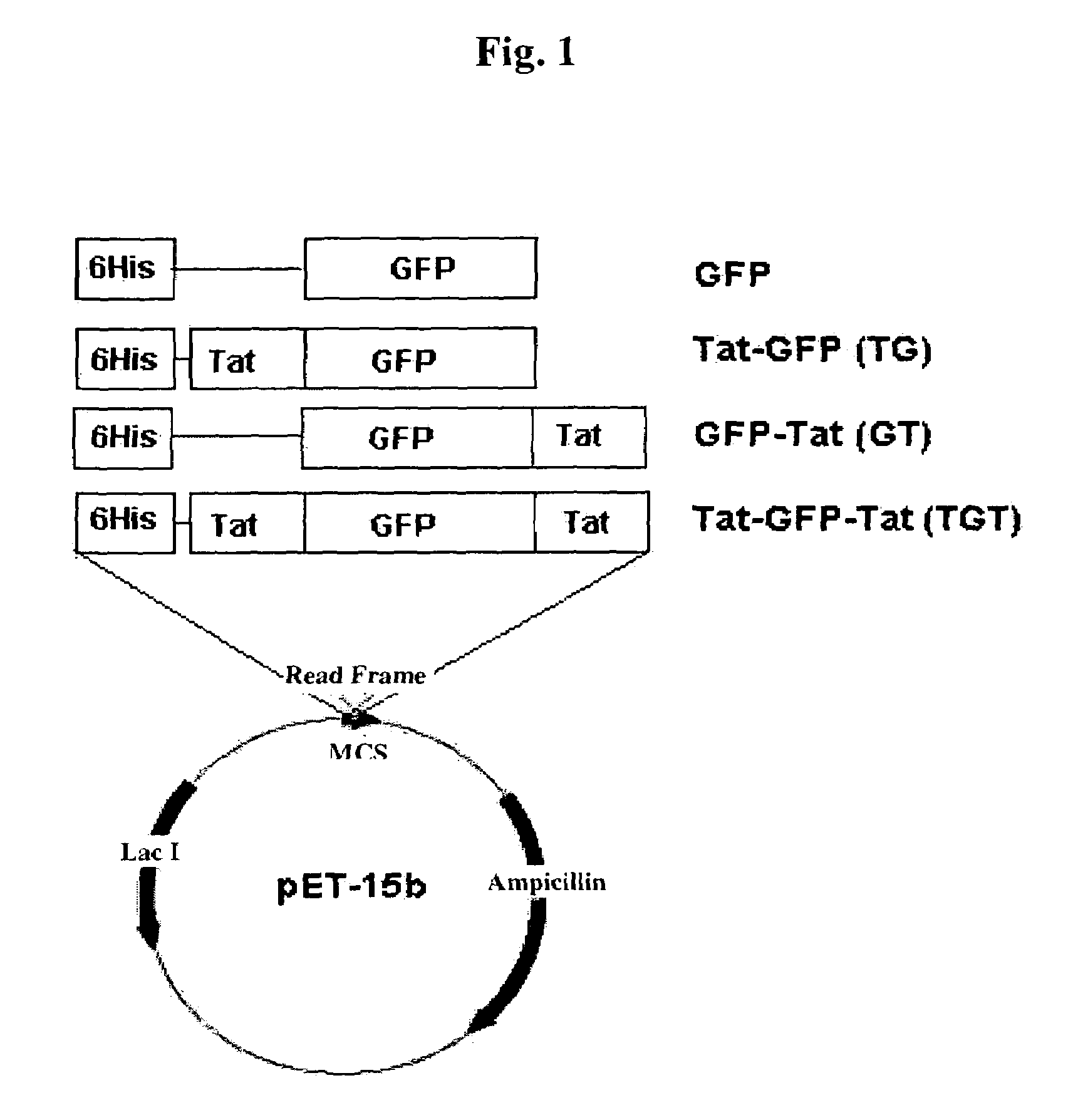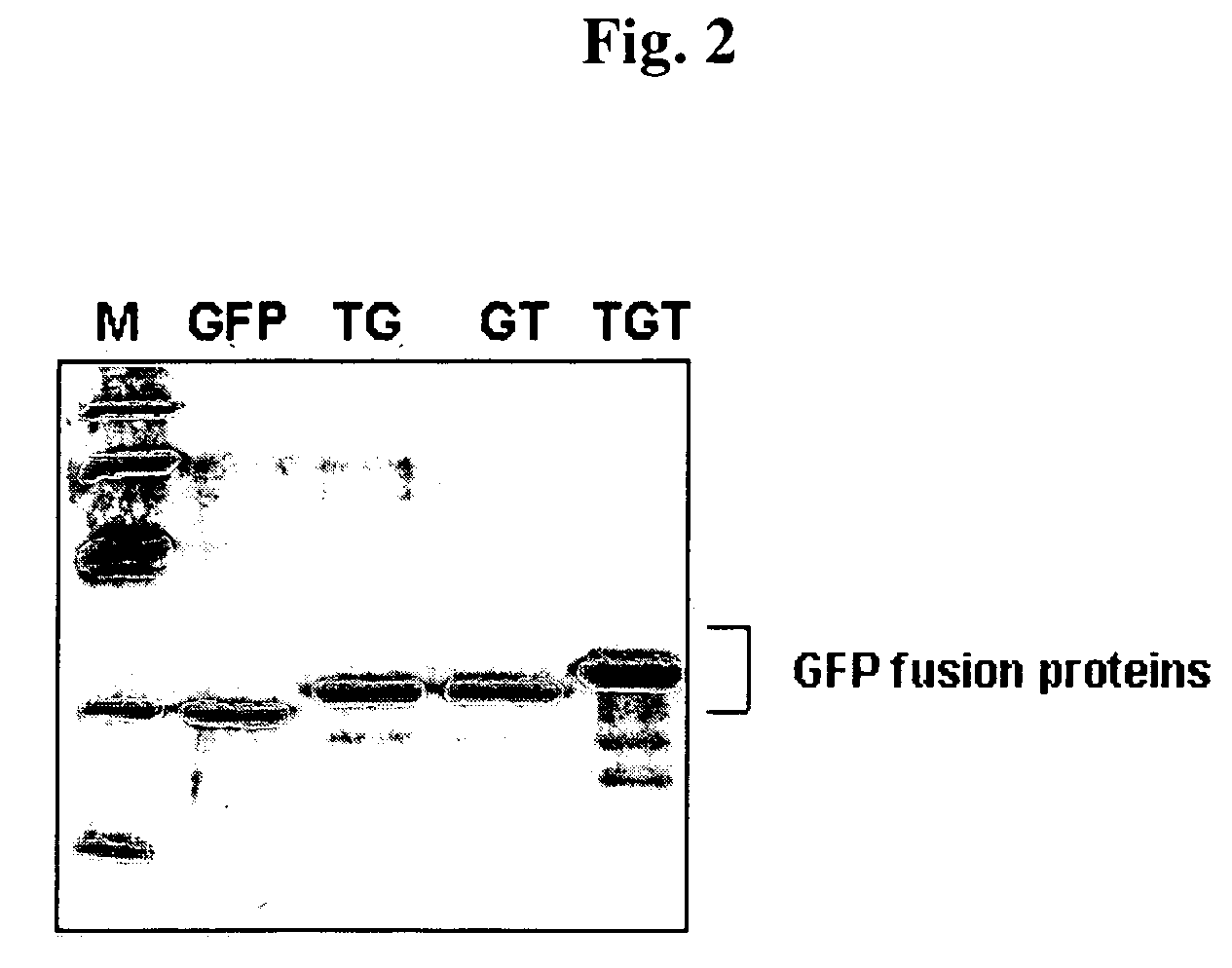Advanced cell-transducing transport domain-target protein-transport domain fusion protein and uses thereof
a technology of transport domain and transport domain, which is applied in the direction of his-tag polypeptides, drug compositions, peptides, etc., can solve the problems of insufficient stability, inconvenient use of cosmetic compositions, damage to living bodies, etc., and achieves convenient addition to basic cosmetics, improved physical properties of creams, and easy production
- Summary
- Abstract
- Description
- Claims
- Application Information
AI Technical Summary
Benefits of technology
Problems solved by technology
Method used
Image
Examples
example 1
Production of Transduction Domain Fusion Protein Expression Vector
[0065]To develop a technology of delivering a functional protein or peptide into a cell, fusion protein expression vectors capable of delivering the target protein into the cell were produced.
[0066]In this example, to facilitate the analysis of the ability of a transduction domain to deliver a target protein into a cell, a green fluorescence protein (referred to as “GFP” in the specification) was selected as a target protein. A DNA fragment corresponding to the base sequence of GFP was subjected to polymerase chain reaction (PCR) using plasmid pEGFP-C2 (Clonetec) to amplify the complete sequence of GFP. In this PCR, the sequence of a sense primer was 5′-CTCGAGGTGAGCAAGGGCGAGGAGCTG-3′ (SEQ ID NO: 1), and the sequence of an antisense primer was 5′-GGATCCTTACTTGTACAGCTCGTCC ATGCCGAG-3′ (SEQ ID NO: 2). The PCR product was cut with XhoI-BamHI, and subcloned into the XhoI-BamHI site of pET15b (Invitrogen, Carlsbad, Calif.) ...
example 2
Expression and Purification of Tat-GFP, GFP-Tat and Tat-GFP-Tat Fusion Proteins (Native and Denatured States)
[0070]E. coli BL21 (Pharmacia) transformed with pGFP and pTat-GFP, pGFP-Tat and pTat-GFP-Tat, and the like, was selected, and then the colony was inoculated to an LB medium containing 100 μg / ml ampicillin and cultured at 37° C. overnight. The cultured medium was 10-fold diluted in a fresh LB medium and cultured with stirring at 250 rpm. When the bacterial concentration (the optical density at a 600 nm wavelength) in the cultured medium reached 1.0, IPTG was added into the cultured medium to a final concentration of 0.5 mM and then the cells were cultured for 4 hours.
[0071]To obtain the cultured cells were added to a denatured transduction domain-GFP fusion protein, a binding buffer (5 mM imidazole, 0.5M NaCl, 20 mM Tris-HCl, pH 7.9) containing 6M urea and a protease inhibitor (20 mg / ml soybean trypsin inhibitor, 2 mg / ml aprotinin, 5 mg / ml leupeptin, 100 mg / ml PMSF). The mixtu...
example 3
Culturing of Cells and Test of Intracellular Transduction of Fusion Proteins
[0073]HeLa cells were cultured in DMEM (Dulbecco's modified eagle's medium) containing 20 mM HEPES / NaOH (pH 7.4), 5 mM NaHCO3, 10% fetal bovine serum (FBS) and antibiotics (100 μg / ml streptomycin, 100 U / ml penicillin) at 37° C.
[0074]In order to observe the intracellular transduction of a transduction domain fusion protein where a HIV-1 Tat protein transduction domain consisting of 9 amino acids (49-57) was bound to the amino-terminal end and / or the carboxyl-terminal end, the following test was performed. Namely, in order to observe the ability of transduction domain-GFP, GFP-transduction domain, transduction domain-GFP-transduction domain fusion proteins to be transduced into cells, the HeLa cells were grown on a 6-well plate for 4-6 hours, and replaced by a fresh DMEM culture medium containing 10% FBS, and then GFP fusion proteins were added to the cultured medium at various concentrations. After culturing ...
PUM
| Property | Measurement | Unit |
|---|---|---|
| molecular weight | aaaaa | aaaaa |
| optical density | aaaaa | aaaaa |
| pH | aaaaa | aaaaa |
Abstract
Description
Claims
Application Information
 Login to View More
Login to View More - R&D
- Intellectual Property
- Life Sciences
- Materials
- Tech Scout
- Unparalleled Data Quality
- Higher Quality Content
- 60% Fewer Hallucinations
Browse by: Latest US Patents, China's latest patents, Technical Efficacy Thesaurus, Application Domain, Technology Topic, Popular Technical Reports.
© 2025 PatSnap. All rights reserved.Legal|Privacy policy|Modern Slavery Act Transparency Statement|Sitemap|About US| Contact US: help@patsnap.com



